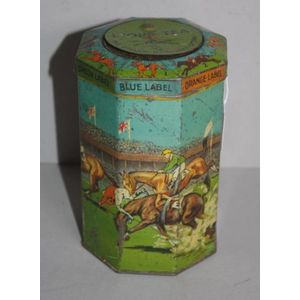
Archibald Knox English Pewter Tea Caddy with Honesty Leaf
An English Pewter tea caddy or biscuit box designed by Archibald Knox decorated with the Honesty leaf motif, square swollen shape, the lid with double bar handle. Marked 'English Pewter 0194', height 4.72 in.mm x 4.13 in. square.

Butterfly-themed Vintage Tea Caddy
Vintage tea caddy, cast metal decorated with multiple butterflies and internal lid with butterfly finial

17th/18th Century Tin Glazed Earthenware Tea Caddy
An antique tin glazed earthenware tea caddy, 17th/18th century, 4.13 in. high

Brass-handled sarcophagus tea caddy, 28cm length
Early Sarcophagus form tea caddy decorative brass handle to lid, original interior sections have been removed, length 11.02 in.

Sterling Silver Tea Caddy in Tin Form, 1910
An English sterling silver tea caddy in the form of a tin, by Stewart Dawson & Co. London, circa 1910, 4.33 in. high, 3.74 in. diameter, 268 grams

Georgian Satinwood Tea Caddy with Marquetry and Brass Pulls
Georgian oval satinwood and marquetry tea caddy, c. 1790, decorated with wreath, bow and arrow, the lid with a brass pulls and floral marquetry, with key, height 4.72 in. width 5.91 in. depth 3.54 in. Provenance: Martyn Cook Antiques Sydney, the…

Art Deco Tea Caddy for Liberty & Co
An English pewter 'Tudric' Art Deco tea caddy, made for Liberty & Co. London, circa 1930, 3.54 in. high

Chinoiserie Lacquer Tea Caddy with Fitted Interior
Antique chinoiserie lacquer tea caddy decorated lacquer case, damage to 1 hinge, with lid opening to fitted interior, with decorated inner pewter lid with carved ivory knob, opening to fitted pewter tea container, length 9.84 in., height 5.91 in.

Gilt and lacquered Chinese tea caddy with figural scenes
A Chinese export gilt and lacquered tea caddy, of rectangular form decorated with figural scenes within shaped reserves on dragon and floral decorated ground, the interior with chased pewter lidded liner. With various cartouche depicting tea production and

Ornate Rosewood Tea Caddy with Brass Inlays
Regency rosewood and brass tea caddy sarcophagus shape with ornate brass floral and scroll inlays, 9.84 in. width.

Victorian Brass Tea Caddy with Key
A Victorian brass bound tea caddy, height 6.10 in. x, length 10.04 in., depth 5.91 in., with key

Antique Wood Tea Caddy with Tin Lining
Antique wood tea caddy with divided interior, remnants of tin lining to interior, height 5.12 in.

Gold Lacquer Tea Caddy with Figures and Foliage Design
A Chinese Canton export lacquer tea caddy, 19th century, decorated with figures in landscapes and scrolling foliage in gold lacquer on a black ground. Opening to two pewter tea canisters., 8.27 in. high, 14.57 in. wide, 10.63 in. deep

Victorian Chinoiserie Tea Caddy with Tin Liner
A Victorian chinoiserie tea caddy, the interior with tin liner, the lid decorated with conforming chinoiserie designs, ivory button, width 6.50 in., depth 4.53 in., height 3.74 in.

Lyons Tea Caddy with Steeple Chasing Horses Decoration
Edwardian tinplate lithographed tea caddy, marked 'Lyons' Tea-The Grand National Drink,' with decoration of steeple chasing horses, height 5.91 in.

Colorful Tea Canister - 40cm
A painted tin tea canister, 15.75 in. high

Berlin Hand-Painted Porcelain Tea Caddy with Classical Figures
An old Berlin hand-painted porcelain tea caddy, the front and back panels painted with classical figured scenes, jewelled gilt borders on cobalt ground, the sides, top and lid with further conforming detail, underglaze blue mark, signed J. Koller, the base

French Ebonized Tea Caddy with Tortoise Shell & Brass Decorations
Antique French ebonized tea caddy, decorated with tortoise shell & brass banding

Pewter Tea Caddy: Oriental Elegance
Oriental pewter tea caddy

22cm Pewter Tea Caddy
Pewter tea caddy, approx 8.66 in. high

22cm Pewter Tea Caddy
Pewter tea caddy, approx 8.66 in. high

34cm Tole Ware Tea Canister
Tole ware tea canister approx 13.39 in. high

Victorian Chinoiserie Tea Caddy with Fitted Canisters
A mid Victorian octagonal black lacquered tea caddy with painted gilt Chinoiserie decoration. The interior with original fitted tin lidded engraved tea canisters, circa 1850. Length 9.06 in.